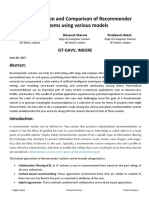0% found this document useful (0 votes)
16 views15 pagesData Engineer Interview 1738557398
The document outlines key questions and answers related to data engineering, covering topics such as the differences between OLTP and OLAP, handling missing data, designing ETL pipelines, ensuring data quality, and understanding p-values in hypothesis testing. It also discusses normalization vs. standardization, optimizing SQL queries, handling skewed data distributions, and distinguishing between Type I and Type II errors. Additionally, it provides guidance on choosing between RDBMS and NoSQL, data normalization in databases, and detecting and handling outliers.
Uploaded by
Mahesh MarupakulaCopyright
© © All Rights Reserved
We take content rights seriously. If you suspect this is your content, claim it here.
Available Formats
Download as PDF, TXT or read online on Scribd
0% found this document useful (0 votes)
16 views15 pagesData Engineer Interview 1738557398
The document outlines key questions and answers related to data engineering, covering topics such as the differences between OLTP and OLAP, handling missing data, designing ETL pipelines, ensuring data quality, and understanding p-values in hypothesis testing. It also discusses normalization vs. standardization, optimizing SQL queries, handling skewed data distributions, and distinguishing between Type I and Type II errors. Additionally, it provides guidance on choosing between RDBMS and NoSQL, data normalization in databases, and detecting and handling outliers.
Uploaded by
Mahesh MarupakulaCopyright
© © All Rights Reserved
We take content rights seriously. If you suspect this is your content, claim it here.
Available Formats
Download as PDF, TXT or read online on Scribd
/ 15























































































